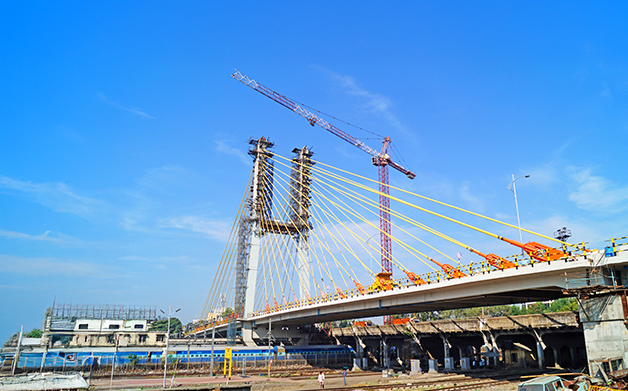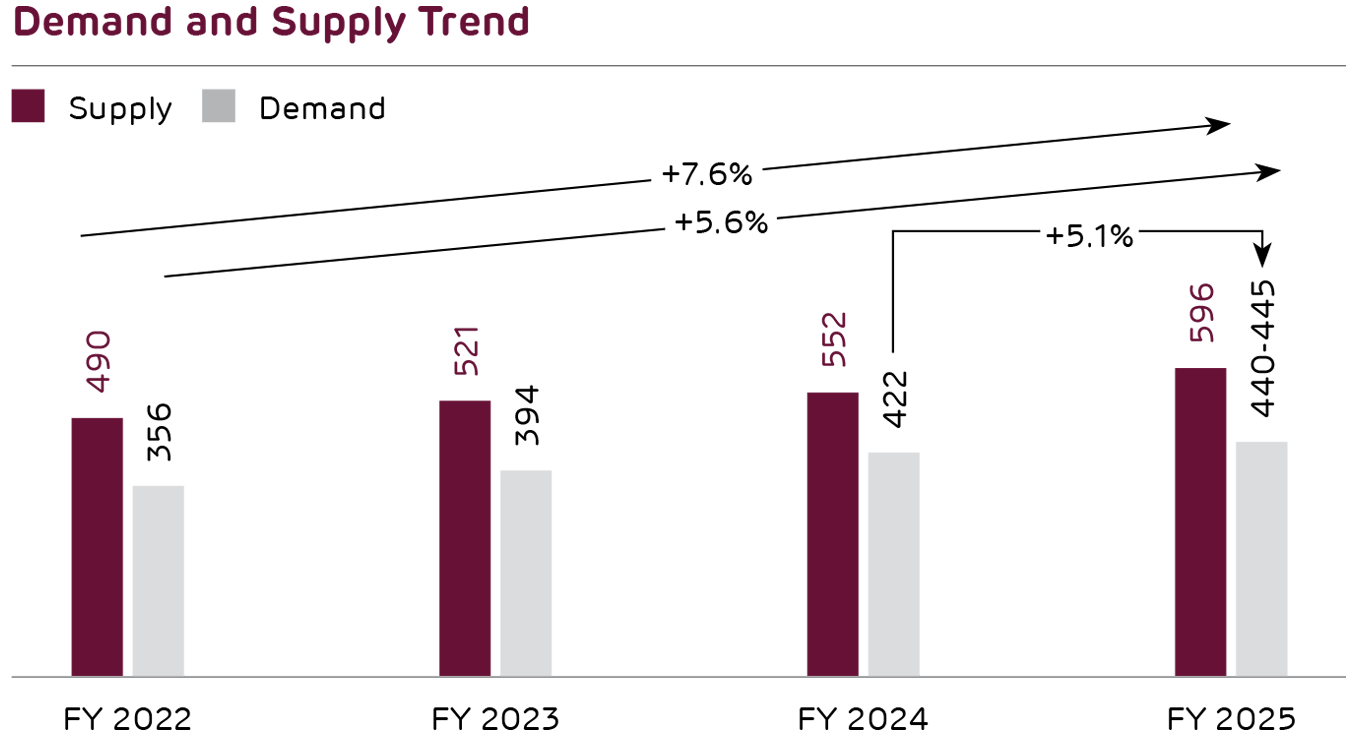India's economy for the decade ending 2023-24, grew at an average rate of 6%. Decadal growth was fuelled by pandemic recovery and progressive economic reforms. This momentum is likely to continue in the future, driven by favourable demographic, stable governance, robust urban and rural demand, technological advancement and significant government spend on infrastructure. All these initiatives led to a symbiotic relationship between economic prosperity and cement industry’s growth with GDP growth projected at 6.5% for FY 2024-25.

Indian Cement Industry
Economic growth often triggers a wave of development and urbanisation, as peoples’ income grow, and they uplift their living standards or migrate to urban centres in search of better job opportunities and improved living standards. This migration necessitates the construction of residential complexes, commercial establishments, and infrastructure facilities, all of which require substantial amounts of cement. As urbanisation accelerates, the demand for cement escalates, driving the industry to expand production capacities and innovate production techniques.
Driven by sustained demand from the housing and infrastructure sectors, cement volumes are expected to grow by 4-5% annually, reaching 440-445 million metric tonnes (MT) in FY 2024-25. This growth is projected to continue, with an increase of 6-7% annually, reaching 475-480 million MT in FY 2025-26.2
The Indian cement industry is set for significant growth, with installed capacity expected to reach 850 million tonnes per annum (t/a) by 2030 and 1,350 million t/a by 2050.3 Strong economic fundamentals, including robust GDP growth, India’s transition to a middle-income nation and an expanding working-age population, will drive cement demand.
Additionally, income tax cuts and substantial capital expenditure plans are expected to boost housing and infrastructure development. The Cement Manufacturers’ Association (CMA) aims for a compound annual growth rate (CAGR) of over 6% in installed capacity, with capacity expansion and mergers and acquisitions anticipated as key industry trends.4
2nd Largest
Cement Producer in the World
686 MT
Installed Capacity
6%
Forecasted CAGR of Installed Cement Capacity by CMA
2ICRA, 3IBEF, 4CMA
Continued Expansion of the Indian Economy
The Indian economy, one of the world's largest- and fastest-growing, has shown remarkable resilience and dynamism in recent years. As we look ahead to FY 2026, the continued expansion of this vibrant economy is expected to further bolster its position on the global stage and the economy is projected to expand by 6.5%5. This growth is driven by a confluence of factors, including robust domestic demand, strategic government initiatives, technological advancements and a favourable global economic environment.
6.5%
Forecasted GDP Growth of Indian Economy in FY 2025-26
Projected GDP Growth
(%)Infrastructure Push
The Union Budget for FY 2025-26 has allocated ` 11.21 lakhs crore for capital expenditure (CAPEX), marking a 10% increase from the revised estimate of ` 10.18 lakhs crore (USD 116.78 billion) for FY 2024-25. The Budget prioritises infrastructure investment to fuel economic growth, stimulate demand and enhance productivity across key sectors. It also encourages public-private partnerships (PPPs) to improve execution and increase private sector involvement in infrastructure development.6
` 11.21 lakhs crore
Allocated CAPEX in Union Budget for FY 2025-26
Expanding Housing Sector
The desire for homeownership, particularly in the post-pandemic era, is driving the growth of India’s housing sector across both urban and rural areas. As the largest consumer of cement, the housing sector currently accounts for around 65% of the country’s cement demand. This expanding sector will continue to be a key driver of future demand, playing a vital role in the industry’s growth and shaping India’s infrastructure landscape.
~65%
of India’s cement demand comes from the housing sector
Key Growth Drivers
Population Growth
With a population nearing 1.5 billion, India has become the world’s most populous country, generating consistent and significant demand for housing. A large portion of this population is within the working age group, further fuelling the growth of the real estate sector and its potential.
Urbanisation and Infrastructure Development
Rapid urbanisation, coupled with government initiatives such as the Smart Cities Mission, PMAY and AMRUT, is driving demand for residential, commercial and infrastructure projects, thereby boosting cement consumption.
Rural Development Investments
Government-backed projects focusing on rural roads, schools, healthcare, and sanitation have spurred cement demand in rural areas, opening up new market opportunities.
Technological Advancements and Innovation
Adoption of advanced manufacturing technologies is improving efficiency, lowering costs and enhancing product quality. Innovations like green cement, ready-mix concrete and specialty cements cater to evolving construction needs and promote sustainability.
Industry Consolidation
Mergers and acquisitions, with approximately 200 million tonnes of capacity consolidated over the past decade, have resulted in more efficient operations, optimised production, and economies of scale.
Environmental Sustainability
With increasing environmental regulations, cement manufacturers are adopting cleaner, more sustainable practices, reducing carbon footprints while boosting their competitiveness in the market.

Ambuja Cements’ Positioning
India’s per capita cement consumption is 250 kg, far below China’s 1,600 kg, offering substantial growth potential. Cement demand is expected to grow 1.2 to 1.5 times GDP, and Ambuja Cements aims for double the industry growth rate. Aligned with India's growth vision, Ambuja Cements is making consistent investments to drive both organic and inorganic growth. The Company is also focused on digital transformation to enhance operational efficiency and boost profitability. Recognising the increasing significance of environmental impact in the cement industry, Ambuja is significantly expanding its capacity for alternative energy generation, reducing reliance on finite resources, and fostering the prosperity and sustainability of local communities in the regions where it operates.
With India set to rapidly grow into a USD 25 trillion economy by 2050, Ambuja Cements is committed to accelerating the growth of its cement business. Since its integration into the Adani Group, the Company has significantly expanded its cement capacity in a short period.
Moving forward, Ambuja Cements aims to reinforce its position as a leader in growth, innovation, operational excellence and value creation.